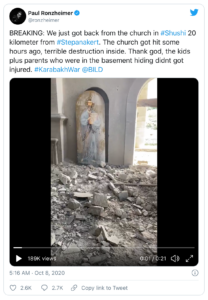
Twitter post after bombing of Ghazanchetsots Cathedral.
Updated February 2, 2021
The modern Armenian-Azerbaijani conflict over Artsakh/Nagorno-Karabakh has been ongoing since 1918, when the newly independent Azerbaijan Democratic Republic and the First Republic of Armenia both claimed the area following the collapse of the Russian Empire. The enclave has a majority Armenian population whose ancestors settled there as early as the 7th century BC. Artsakh is the Armenian name for the region while Nagorno-Karabakh, is the name used in Azerbaijan.
The Soviet Union turned the enclave into the Nagorno-Karabakh Autonomous Oblast (NKAO) within the Azerbaijan Soviet Socialist Republic in 1923. With the fall of the Soviet Union, tensions between Armenian and Azerbaijan reignited in 1988, in the first Nagorno-Karabakh War. Many characterized this six-year long war, during which Armenians gained control of the region, as a fight for ethnic Armenian self-determination. The region has been technically under a cease-fire, since May 12, 1994.
Since 1991, Artsakh / Nagorno-Karabakh has been de facto controlled by the self-declared Republic of Artsakh (formerly named Nagorno-Karabakh Republic (NKR)), but internationally recognized as, de jure, part of Azerbaijan.
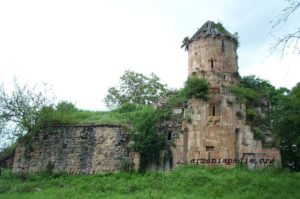
Gtichavank Monastery, Copyright © 2005 Raffi Kojian, CCA-SA license, Armeniapedia
The ceasefire has been breached multiple times, most recently from September 27, 2020-November 10, 2020 in the 2020 Nagorno-Karabakh War in which Azerbaijan regained control of strategic portions of Nagorno-Karabakh as well as the majority of the seven districts surrounding the territory; Kalbajar, Lachyn, Gubadly, Zanghilan, Jabrayil, Fuzuli and Agdam.
On November 9, 2020 an armistice agreement was signed by Ilham Aliyev, President of Azerbaijan, Armenian Prime Minister Nikol Pashinyan and Russian President Vladimir Putin. Arayik Harutyunyan, the president of the self-declared Republic of Artsakh, also agreed to an end of hostilities. A Russian peacekeeping force was deployed to the region to protect the Lachin corridor that links Armenia and the Nagorno-Karabakh region. They have also been deployed to protect Armenian cultural heritage sites.
Both Armenia and Azerbaijan claim that each other has engaged in ethnic and cultural cleansing over the last one hundred years, pointing to ethnically motivated massacres, land grabs, and cultural destruction. The truth is often very complicated.
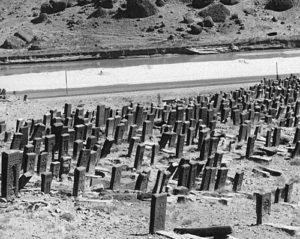
Photograph of khachkars from Julfa, now destroyed by Azeri soldiers. Nakhichevan, Azerbaijan by A. Ayvazyan. Before 19 December 2006. www.armenica.org. Wikimedia Commons.
Armenia accuses Azerbaijan, in the best of cases, with “Caucasian Albanizing” Armenian cultural heritage by erasing Armenian inscriptions and connecting sites to a Caucasian Albanian culture that coexisted with Armenian culture through much of its history and ceased to exist around the 8th century.
According to experts and a recent report from the office of the Human Rights Ombudsman of the Republic of Artsakh, this process of historical revisionism, which has been ongoing since the 1950s, is an effort by Azerbaijan to strengthen its ties to the region. By claiming that Armenian churches, monuments, and the stone-cross khachkars are the work of the historic Caucasian Albanians, and that Caucasian Albanians are Azerbaijani peoples’ ancestors, they “eradicate Armenian peoples’ historical roots to the region and thereby diminish their entitlement to live in and govern these areas while fabricating an Azerbaijani historical presence.” Most scholars say that the Udi people are the actual descendants of the Caucasian Albanians.
In other cases, Armenia cites Azerbaijan’s complete destruction of Armenian cultural heritage in various regions. For example, in Nakhichevan, Azerbaijan, the Azerbaijan government destroyed 89 medieval churches, 5,840 intricate cross-stones (khachkars), and 22,000 gravestones between 1997 and 2006 and then denied that they ever existed. Despite Azerbaijan’s claims, records were made of these sites, and in some cases, there is video and photographic documentation of their destruction by Azeri soldiers.

Argam Ayvazyan next to a 14th-century khachkar in Nors (today Nursu), near his birthplace (© Argam Ayvazyan archives, 1970-1981) (courtesy Djulfa Virtual Memorial and Museum | Djulfa.com)
Turkey’s backing of Azerbaijan in the 2020 Nagorno-Karabakh war and its history of Armenian cultural genocide has also raised serious cause for concern among Armenians.
Azerbaijan officials have made similar claims and say that the Armenians living in Artsakh/Nagorno-Karabakh have “Armenianized” Azeri cultural sites. They also state that Armenians have damaged or “destroyed 927 libraries, more than 60 mosques, 44 temples, 473 historical sites, palaces and museums… and “illegally [removed] 40,000 museum exhibits” during their occupation of the region.
Armenian cultural heritage at stake
As a result of the ceasefire and Azeri taking of control over Artsakh/Nagorno-Karabakh, it is Armenian cultural heritage that is now placed at risk. At stake are multiple sites sacred to the indigenous Armenian population, many of whom have fled.
An overwhelming majority of the population of Nagorno-Karabakh was ethnically Armenian. The surrounding seven districts have a majority Azeri population. Azerbaijan’s government policy of deliberately erasing Armenian culture, especially in the Azerbaijan exclave of Nakhichevan, as documented by Argam Ayvazyan and reported by Simon Maghakyan and Sarah Pickman in “A Regime Conceals Its Erasure of Indigenous Armenian Culture”, has caused international concern that the same will happen in Artsakh/Nagorno-Karbakh now that much of it is under Azerbaijan’s control.

Painting of Mesrop Mashtots, inventor of the Armenian alphabet in Amaras Monastery in Artsakh (Nagorno-Karabakh), photo by Yerevantsi, 5 March 2018, CCA-SA 4.0 International license
A January 2021 report from the office of the Human Rights Ombudsman of the Republic of Artsakh states that at least 1,456 Armenian historical, cultural, and religious sites are now under the control of Azerbaijan. These include “161 monasteries and churches, 591 khachkars, 345 tombstones and inscribed stones, 108 tombs, cemeteries, burial mounds, and sanctuaries, and 43 fortresses, castles and palaces.”
Dorian Batycka discussed churches and monuments from the early days of Christianity under threat in The Art Newspaper’s “Armenian monuments in line of fire in Nagorno-Karabakh conflict.” Armenia became the first Christian nation in the 4th Century.
In particular, hundreds of medieval khachkars in Nagorno-Karabakh are vulnerable to destruction due to their size and distinctly Armenian form. Khachkars are intricately carved cross-stone steles unique to Armenian Christians. They are sacred sites unto themselves and were erected as gravestones, as well as to commemorate significant events and to mark important places. Though khachkars have been inscribed on UNESCO’s Representative List of the Intangible Cultural Heritage of Humanity since 2010, that didn’t prevent Azerbaijan from completely eradicating them in Djulfa, Nakhichevan.
Armenian human rights activist, political scientist and researcher Simon Maghakyan notes in “Cultural Erasure May Spark Next Nagorno-Karabakh War“, that “five ancient Artsakh monuments are particularly sacred for Armenians” and that if Azerbaijan is interested in cultivating a long term peace in the region then allowing Artsakh Armenians to keep, at the very least, those five monuments would be essential.
Maghakyan’s list begins with the Amaras Monastery located in Nagorno-Karabakh, near the village of Sos. The monastery has come under Armenian control since the article was written, but bears mention due to its significant relationship to Armenian history. The Amaras Monastery was founded sometime in the 4th century through the mission of Gregory the Illuminator after he converted local ruler Tiridates III to Christianity. This Armenian ruler subsequently proclaimed Christianity to be the state religion and actively worked to eradicate prior belief systems. The grave of St. Grigoris, Gregory the Illuminator’s grandson, who was martyred while preaching in the Northern Caucasus in 348 CE, is venerated at Amaras Monastery. The Monastery is also where the first school to teach the Armenian alphabet was located. None other than its inventor, St. Mesrob Mashtots, taught the Armenian script that he created in 406 CE there.
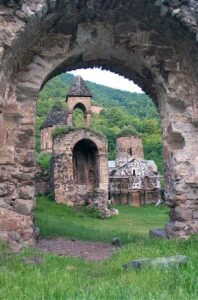
Dadivank Monastery, © 2005 Raffi Kojian., CCA-SA license, Armeniapedia
The Dadivank Monastery has perhaps garnered the most media attention as Armenians evacuating the region came to pray one last time before their departure. The monastery was founded in the first century CE by St. Dadi, a disciple of Thaddeus, one of Jesus Christ’s apostles. The Dadivank Monastery reached the height of its prosperity in the 13th century through the patronage of Prince Vakhtang’s wife Arzu-Khatun. The monastery, located in Kalbajar, is currently under the protection of Russian peacekeepers.
Near Togh Village in the Hadrut Region of Nagorno-Karabakh stands the 13th century Gtichavank Monastery. Rebuilt by two brothers, Sargis and Vrtanes, bishops from Amaras, during the height of the Mongol conquest, the monastery became “an important center of Armenian religion, politics and culture,” according to Armeniapedia. Simon Maghakyan says it is important because it “was a key Cathedral for the autonomous principality of Khachen and its Melikdom successors that relentlessly compromised with Arab, Mongol, Persian, and Turkic conquerors to ensure Armenian existence, even if it meant adopting Islamic names.” It was recaptured by Azeri soldiers in October 2020.
Tigranakert, an important archeological site in the Agdam District, is “the best-preserved city of the Hellenistic and Armenian civilizations” of the Caucasus according to Hamlet Petrosyan, the chair of the Cultural studies Department of Yerevan State University who led excavations there. (See, “Archeologist Raises Alarms Over Azerbaijan’s Shelling of an Ancient City.”) Tigranakert is said to have been shelled a number of times during the 2020 Nagorno-Karabakh conflict and is now under Azerbaijan’s control.

Tigranakert Museum, photo Rob at Armenian Wikipedia, 19 July 2010, public domain.
In the Lachin district, a mere five kilometers from the border of Armenia’s province of Syunik, sits the Tsitsernavank Monastery. Maghakyan notes that it is “one of the first basilica churches in the world” and that “some of its unique architectural features suggest that it may have been founded as a pagan temple before the year 301.” In her December 2020 article for The Conversation, “Armenians displaced from Nagorno-Karabakh fear their medieval churches will be destroyed,” Christina Maranci wrote that, “Tzitzernavank also offers evidence of continued Armenian presence through the early modern period,” citing inscriptions found there from the 10th through the 17th century.
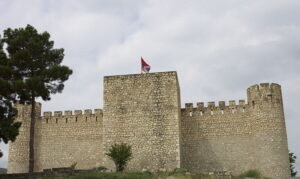
Tigranakert, photo by Raffi Youredjian Photography, 28 December 2013, cc-by-2.0 generic license.
Other sites have garnered Armenian and international attention and concern. Images of the damage to Ghazanchetsots Cathedral in Shushi, Artsakh, also known as Holy Savior Cathedral, during two Azerbaijan air raids sparked outrage. A few days after the destruction, Armenian-born cellist Sevak Avanesyan played the Armenian pilgrimage song ‘Krunk’, a song of longing for one’s homeland transcribed by Armenian composer Komitas, inside the Cathedral. Komitas (October 8, 1869-October 22, 1935) was an Armenian priest and ethnomusicologist who is a symbol of the Armenian genocide. The atrocities he witnessed left him in a severe post-traumatic neurosis from which he never recovered. The bombing of Ghazanchetsots Cathedral happened on the one hundred fifty first anniversary of his birth.
In an article in The Armenian Weekly entitled “Shushi’s Ghazanchetsots Cathedral Bombed” author Lillian Avedian sums up the significance of the Cathedral for Armenians, “Ghazanchetsots is a site of immense spiritual significance for the people of Artsakh, not only due to its consecration, but also due to its role throughout the history of the country’s struggles for self-determination. The 19th-century cathedral was desecrated and severely damaged in 1920 during the Shushi massacres.”
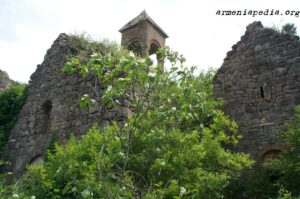
Yeghishe Arakyel Monastery, Copyright © 2005 Raffi Kojian, CCA-SA license, Armeniapedia.
She continues, “Between 1989-1992 during the Artsakh Liberation War, the church was used as an armory for the Azerbaijani military in Shushi, while the city was employed as a stronghold for firing upon Stepanakert. In 1992, following the liberation of Shushi, Armenian forces recaptured and restored the damaged cathedral.”
Another important site, Yeghishe Arakyal Monastery, is considered “a key sacred site for Armenians” according to Simon Maghakyan. It is currently “in ‘no man’s land’ between Armenian & Azerbaijani positions in northeast Karabakh, west of Mataghis.”
The Yeghishe Arakyal Monastery was first constructed in the fifth century. Its founding is attributed to King Vachagan Barepasht, who some scholars claim was an Armenian king and others a Caucasian Albanian king. The monastery went through periods of decline and rebuilding over the centuries. The current church bears an inscription above the door that states it was built in 1284.
International appeal to preserve Armenian cultural heritage in Artsakh
The Armenian General Benevolent Union, considered the largest and most influential diaspora-Armenian organization in the world, wrote an open letter signed by numerous international academics, seeking the preservation of cultural heritage in Artsakh. Citing the popularity of the exhibit Armenia! at the Metropolitan Museum of Art, Armenian culture at the Smithsonian Folklife Festival’s program Armenia, Creating Home, and the Summit of the Francophonie hosted in Armenia’s capital of Yerevan, and invoking Turkey’s support of Azerbaijan and continual denial of the Armenian Genocide, the organization appealed to the global community to protect and preserve Armenian heritage in Artsakh.
On November 16, 2020 the International Council of Museums (ICOM) Armenia and the Armenian International Council on Monuments and Sites (ICOMOS) sent a joint letter calling on UNESCO “to take all the necessary measures for the security and preservation of the Armenian moveable and immovable cultural heritage in the territory of Azerbaijan.”
The letter specifically stated that:
“Azerbaijan launched two intentional airstrikes on the masterpiece of Armenian architecture – the Holy Savior Ghazanchetsots Cathedral, located in the cultural capital of Artsakh, Shushi, causing significant damages. Tigranakert, which is a major Hellenistic and Armenian archaeological site founded by Tigranes the Great in 95-55 BCE, was targeted, as well. This 2000-year-old city became an area of intensive war activity and was shelled several times, causing serious damages and destruction.”

A Djulfa khachkar, one of a dozen survivors removed from Nakhichevan during or before the Soviet era, at The Metropolitan Museum of Art’s Armenia! exhibit, loan from Armenia’s Mother See of Holy Etchmiadzin (© Simon Maghakyan, courtesy Djulfa Virtual Memorial and Museum | Djulfa.com)
The letter also noted that 12 of 24 museums had been bombed without an opportunity to safely remove their collections and that:
“The intentional targeting, destruction, and misappropriation of cultural heritage sites are a gross violation of the 1954 Hague Convention for the Protection of Cultural Property in the Event of Armed Conflict and its two Protocols.
This stems from a context of deep Armenophobia and anti-Armenianism, which is prevalent in Azerbaijan at all levels of society. This anti-Armenian sentiment is a diverse spectrum of negative feelings, dislikes, fears, aversion, derision, and prejudice against Armenians and Armenian culture. Hate speech and statements demonstrating intolerance against Armenians are encouraged at the highest political level in Azerbaijan, creating a conducive ground for unprecedented hate crimes. As a result, Armenian cultural heritage becomes a victim of revenge through a policy of cultural genocide, which has been practiced by Turkey and Azerbaijan for over a century.”
UNESCO unable to undertake mission
Prior to the start of the war, UNESCO, noting the escalation of violence in Nagorno-Karabakh, reminded all sides of “their obligations under international humanitarian law, notably under the 1954 Hague Convention for the Protection of Cultural Property in the Event of Armed Conflict and its two (1954 and 1999) Protocols, to ensure the prevention of damage to cultural heritage in all its forms.” Both Armenia and Azerbaijan are parties to the Convention.
In November 2020, after the ceasefire agreement, the Director-General of UNESCO, Audrey Azoulay received representatives from Armenia and Azerbaijan and proposed sending a mission to Nagorno-Karabakh to inventory “the most significant cultural assets.” She reminded them that the Convention and its two protocols are based on the States Parties’ conviction that “damage to cultural property belonging to any people whatsoever means damage to the cultural heritage of all mankind”.
A month later UNESCO announced that it was “awaiting Azerbaijan’s response regarding the Nagorno-Karabakh mission.”
Apparently seeking an alternative intermediate party, in late January 2021 George Nelson wrote in “Azerbaijan refuses to hand over 1,500 artworks after seizing ‘cultural capital’ in Nagorno-Karabakh,” that, “Artsakhi ministers have asked Russia to intervene in their bid to recoup paintings, sculptures, and precious stones after relinquishing the culturally significant city of Shusha.”
Azerbaijan accuses UNESCO of taking sides – stresses Armenian destruction of Azeri heritage
The Azerbaijani Foreign Ministry responded by calling on UNESCO “not to politicize the protection of cultural heritage in its Nagorno-Karabakh region and surrounding areas,” stating that UNESCO had ignored “appeals… over Armenia’s war crimes on occupied territories over the past 30 years.”

Meeting of President President of Azerbaijan Ilham Aliyev with President Vladimir Putin, 13 June 2015, Wikimedia Commons.
The statement also noted that the Azerbaijan Culture Ministry had started their own inventory of the destruction to religious and cultural monuments by Armenians in Nagorno-Karbakh and had submitted a report with photos to UNESCO.
A few days later Azerbaijan’s President Ilham Aliyev accused “UNESCO of turning blind eye to sites destroyed by Armenia.”
On a visit to the Fuzuli and Jabrail districts, President Aliyev delivered several impassioned speeches reported on the President’s website, saying in part:
“The Second Karabakh War is our glorious Victory. The occupied territories have been liberated from the occupiers. The damage caused by the enemy is being calculated and will be calculated accurately. All the affected people will return to their ancestral lands with state support. We will carry out this work in a planned way – the calculation of damage, accurate records, and then the reconstruction work…”
In Fuzuli, he addressed the severe damage to the town:
“Look what these savages have done to our city! They have destroyed everything; they have demolished houses and destroyed the entire infrastructure. There is not a single building standing. The whole world should see what the Armenian savagery means, and we will show it to the entire world, not only Fuzuli but also Agdam and other cities. It was as if a savage tribe had devastated these lands. They wanted to destroy and plunder everything, to erase our cultural, historical and religious heritage, but they could not achieve what they wanted. Because we had to come back, we had to return. We have come back, we have returned. We have driven the enemy out of our lands and raised the State Flag of Azerbaijan here. From now on, we will live on this land, as we have done for centuries; our people have lived here for centuries… The despised enemy had also changed the name of Fuzuli, gave it some ugly name. Fuzuli is named after our genius, our great poet Mahammad Fuzuli. We have restored this name. The destroyed city of Fuzuli is a living witness to Armenian fascism.”
Though the guns are mostly silent, the conflict between Azerbaijan and Armenia shows no signs of ending.
Related Articles: UNESCO Exposed! World Heritage Committee Meeting in Baku Will be Hosted by Cultural destroyers
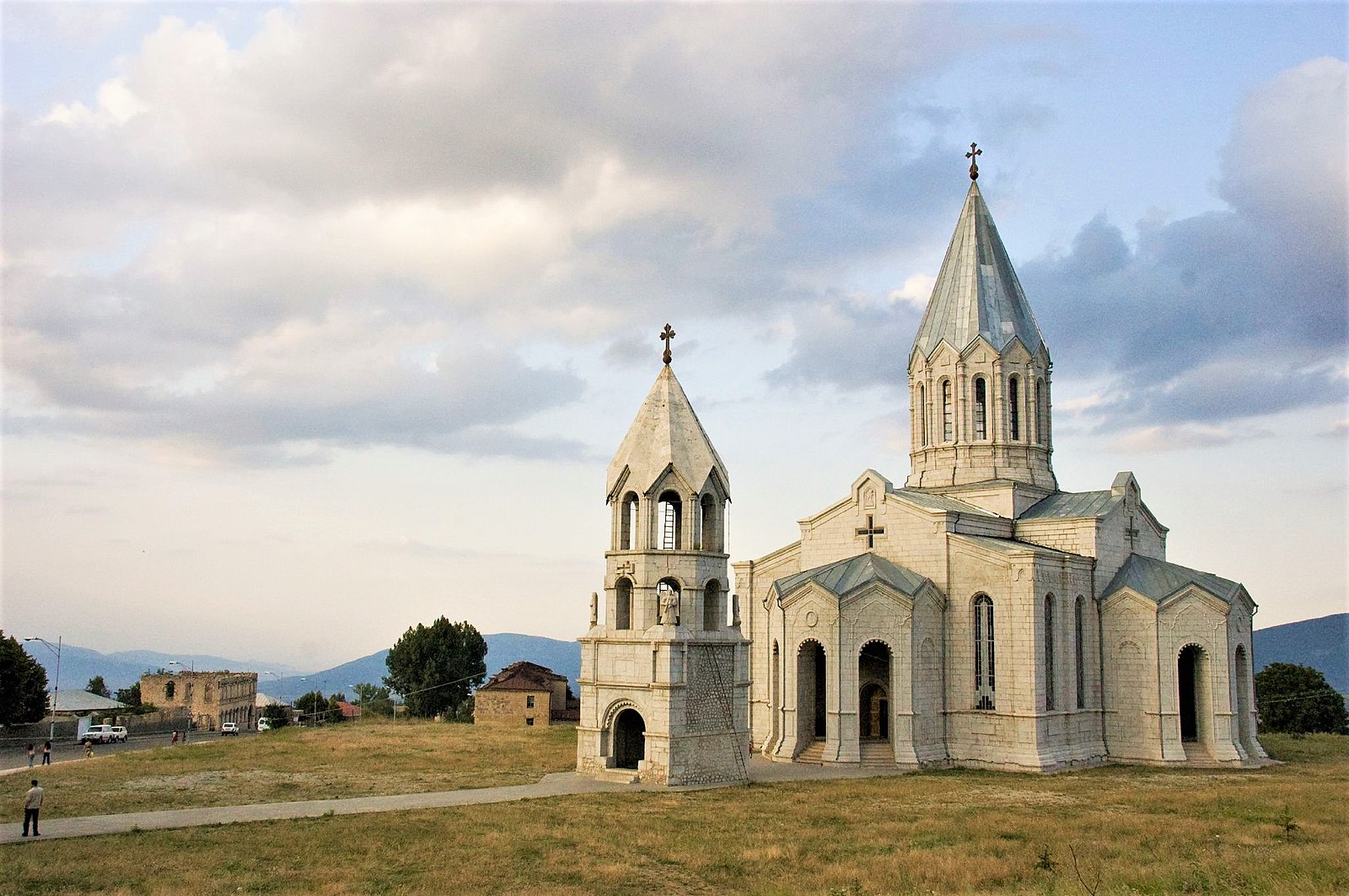 Ghazanchetsots Cathedral, in Shusha, Nagorno Karabakh, photo by Vladimer Shioshvili,
4 August 2007, CCA-SA 2.0 Generic license.
Ghazanchetsots Cathedral, in Shusha, Nagorno Karabakh, photo by Vladimer Shioshvili,
4 August 2007, CCA-SA 2.0 Generic license.


